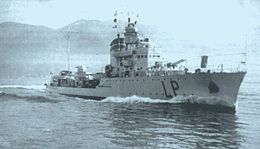
The Italian Destroyer Lampo
On 16 April 1941, four British destroyers operating out of Malta, moved to intercept an Axis convoy moving along the coast of Tunisia. The British were able to intercept the convoy due to intercepted radio messages (but it was not Ultra). The Axis convoy consisted of three Italian destroyers protecting four German troopships and an Italian ammunition ship. The British attacked at night, having radar on several of their destroyers, which the Italians did not have. This night action that started at only 2,000 yards and at times closed to within 50 yards, with the Italians having all three destroyers and all five cargo ships sunk or beached. This one sided affair also ended up costing the British one destroyer, torpedoed by a sinking Italian destroyer, now commanded by an Italian junior officer. Around 1,800 men were killed in this convoy.

The British Destroyer Mohawk
While I was researching this, I came across a poorly translated article called the “Sinking of the Tarigo Convoy” by Cristiano D’Adamo. This article got my attention because he tracks the accounts of this battle as presented in nine books and accounts from 1948 to 1998. Of those nine accounts, only four mention that the British had radar and only two mention the interception of Italian signals. Seven of the nine accounts were missing critical material as to why the battle shaped up the way it did and why it was so one-sided. His article is here:
https://web.archive.org/web/20060910011054/http://regiamarina.net/engagements/tarigo/tarigo_us.htm
This is an exercise similar to what I did in Appendix VII “A History of the Histories” in my book Kursk: The Battle of Prokhorovka. In that appendix, I tracked a number the accounts of the battles of Kursk and Prokhorovka that had been written over the years. It continues to surprise me how many major errors and significant omissions are made in widely published military historical works.

Interesting post. Good comment. My only solutions are
(1) read widely
(2) I develop quantitative models and, when testing them against historical accounts, you sometimes find this sort of anomaly. It simply could not have happened as described in the accepted historical account. The numbers simply do not add up, and you have to formulate and research an alternative hypothesis.
I don’t know if anyone has another solution.
3) Use unit records
Actually, your second point is pretty interesting. If something does not look right….then maybe it is not right. You don’t get lop-sided exchanges without an understandable reason. This was part of the idea behind Trevor Dupuy’s CEV and what heavily influenced our study on the Sino-Soviet border fighting of 1969.